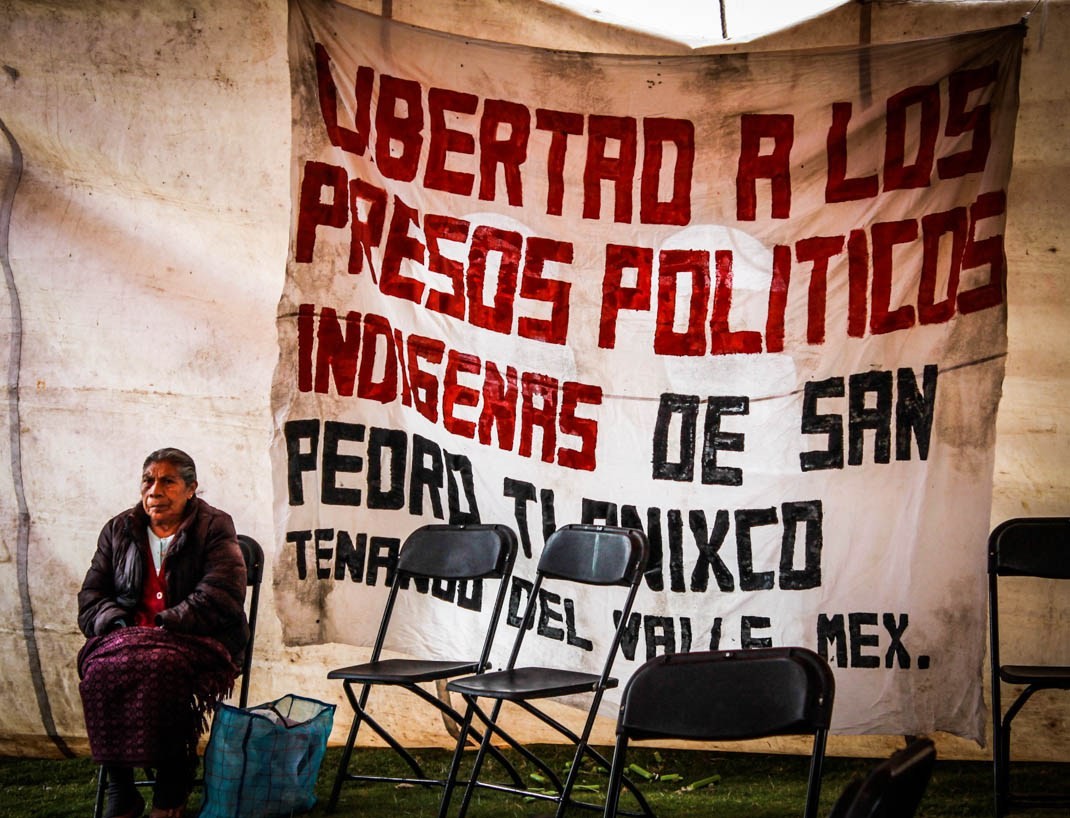Filed under: Action, Indigenous, Land, Mexico

This piece comes from the autonomous media collective, Subversiones, and speaks to the ongoing struggle against territorial and resource dispossession in San Pedro Tlanixco, State of Mexico. The original in Spanish can be found here.
In San Pedro Tlanixco—a Nahua community located in the Mexican municipality of Tenango del Valle—the history of struggle in defense of territory has been long and complex. For decades, the community has faced all forms of dispossession, harassment and violence from local caciques and the three levels of government. But the people of Tlanixco have also shown the capacity to reorganize themselves to respond with dignity against each attack.
The principal object of dispute has been the waters of their Arroyo Grande—the Texcaltenco river, tributary of the Balsas water basin. Their waters, and the other nearby fresh-water springs, have been used historically for domestic use by the inhabitants of Tlanixco. The development of the flower industry in the neighboring municipality of Villa Guerrero was the source of conflict: the businessmen required large quantities of water to maintain their crops.
In 1999, the community of Tlanixco was granted use of four fresh-water springs: Bellotal, Puente de Trozo, Agua Bendita and Salitre. However, that same year, the businessmen of Villa Guerrero, led by Alejandro Isaak Basso, managed to receive authorization for the right to use of those same water sources.
Afterwards, the appeal 1740/2001, filed by the community’s lawyers, managed to suspend the extraction of water to serve Villa Guerrero. The flower growers of that municipality, businessmen linked to the administration of the then governor, Arturo Montiel, continued invading the territory of Tlanixco to provide themselves, illegally, with water for their crops.
It was during one of those illegal invasions in the ejidal territory of Tlanixco, that Alejandro Isaak Basso was confronted by a group from the community in a canyon. Surprised by the confrontation, Isaak Basso apparently had a nervous breakdown and fell down the slope of the canyon. Since then, an unprecedented wave of repression has been unleashed on the community. For years, the people have lived in fear: illegal raids, kidnappings, torture, six political prisons and two others persecuted have been some of the consequences.
But the people of Tlanixco have managed to reorganize and recompose themselves. Just more than two years ago, the community radio was founded and today, the agrarian and civil authorities are working together to take the next step in the struggle.
 In July of 2015, a “friendly agreement” was published, according to which the municipalities of Tenango del Valle and Villa Guerrero modified their territorial limits. Of course, the modification affected the ejidal territory of San Pedro Tlanixco and included the fresh-water spring known as “where the water bursts.” The people of Tlanixco—not informed at the moment of the modification of territorial limits—discovered the maneuver in 2016, when the new ejidal authorities took office.
In July of 2015, a “friendly agreement” was published, according to which the municipalities of Tenango del Valle and Villa Guerrero modified their territorial limits. Of course, the modification affected the ejidal territory of San Pedro Tlanixco and included the fresh-water spring known as “where the water bursts.” The people of Tlanixco—not informed at the moment of the modification of territorial limits—discovered the maneuver in 2016, when the new ejidal authorities took office.
At that point, another title of assignment was discovered, approved by Conagua for the municipality of Villa Guerrero. Unlike a concession, an assignment is authorized only when public use is given to assigned resources. However, it is known that the flower growers of Villa Guerrero sell, even just for an hour, the water that they illegally extract from the territory of Tlanixco.
Faced with this new attack against their territory and water, the community decided to reorganize themselves and group around their agrarian authorities to begin a new process of judicial and political struggle. In the face of the title of assignment, the community’s lawyers presented an appeal arguing that if the waters are property of the nation and not of the ejido, articles 14 and 15 of the Convention 169 of the International Labor Organization make clear that the territorial rights of the Indigenous peoples must be respected. That implies that the people of Tlanixco have the primordial right regarding the administration and utilization of resources, and also have the right to be compensated in cases where that right is violated.
In addition to the legal battle, the people of Tlanixco have decided to take another step to enforce their right by way of action: they have begun to construct a water system from the spring of Estrella. For this action, they have the full right.
The decision of the community exemplifies that territorial autonomy in Tlanixco is not taking one step back. In addition to the judicial struggle and the recuperation of the fresh-water spring, the inhabitants of Tlanixco have decided to organize in their territory a National Forum in Defense of Water on the 18th and 19th of August. “No community is alone, they just have to be organized”, said the present of the ejidal commission in relation to the event. The struggle of Tlanixco is an example of the myriad modes of resistance to combat dispossession. Surely, those forms will multiply in the forum and will serve as tools of struggle for the people who defend water. That is to say, who defend life.





